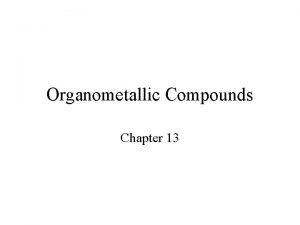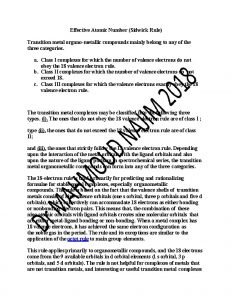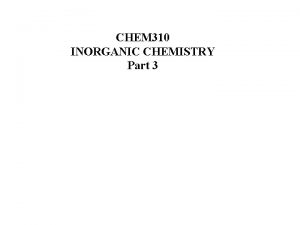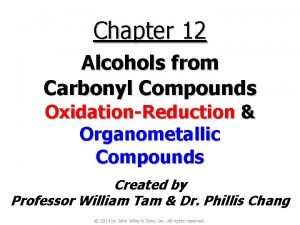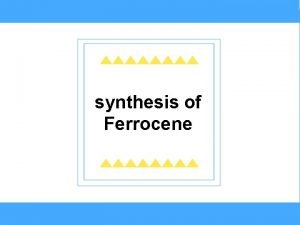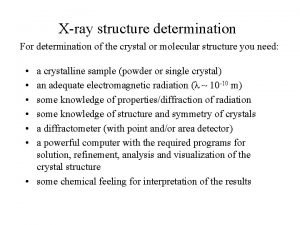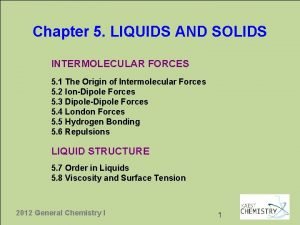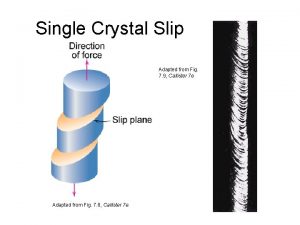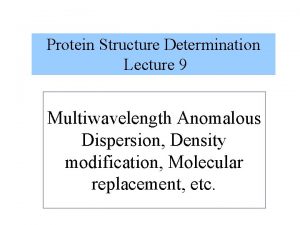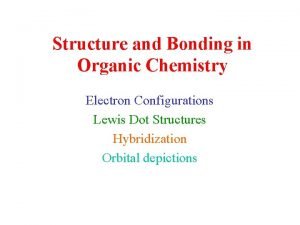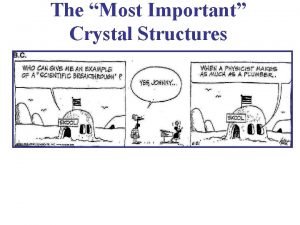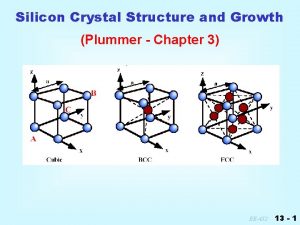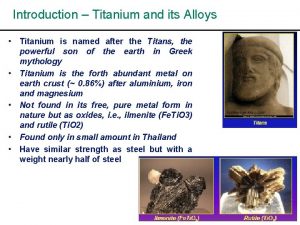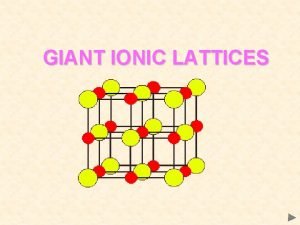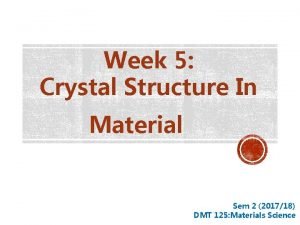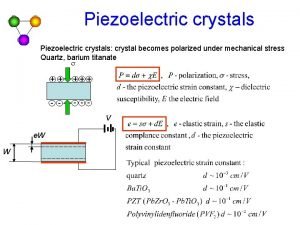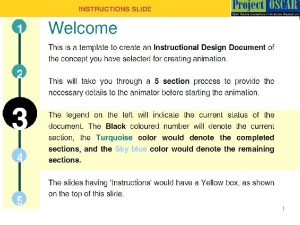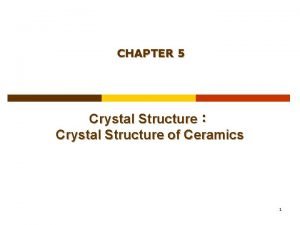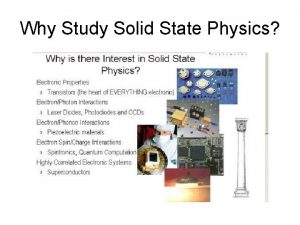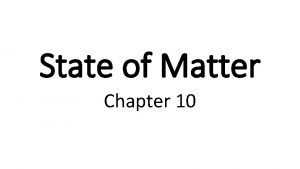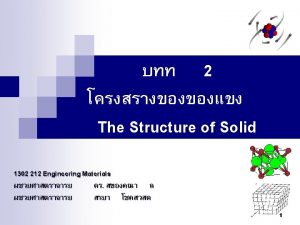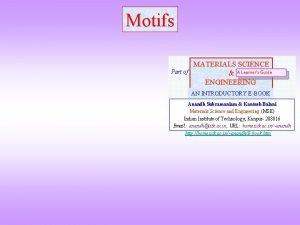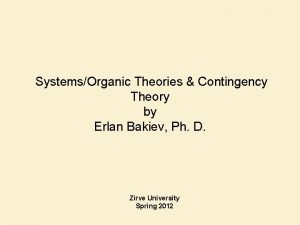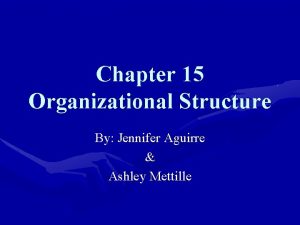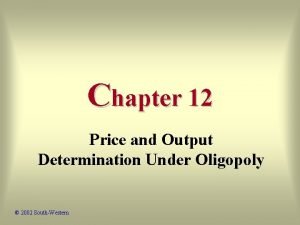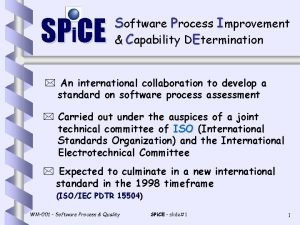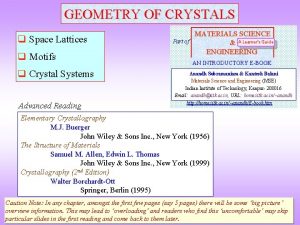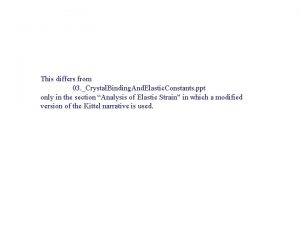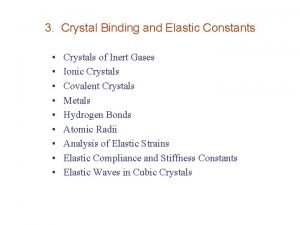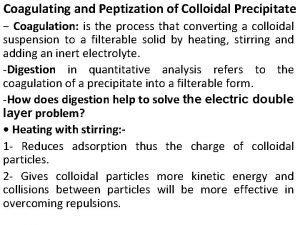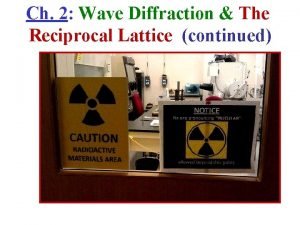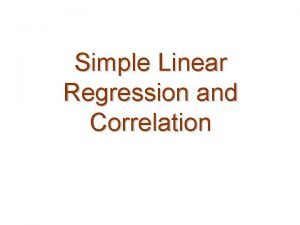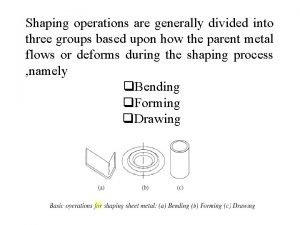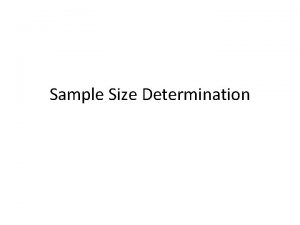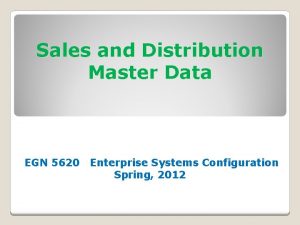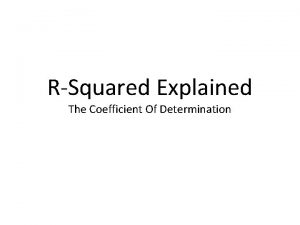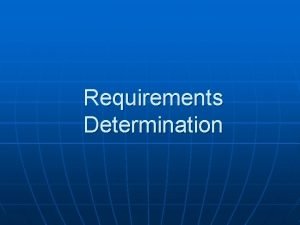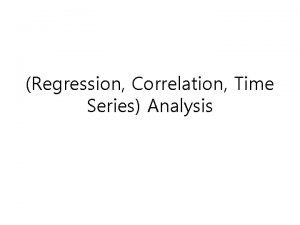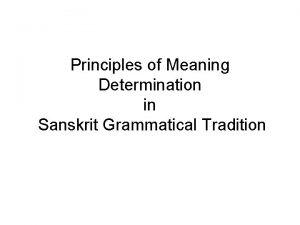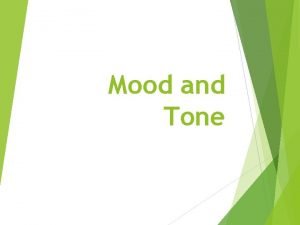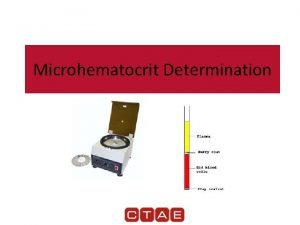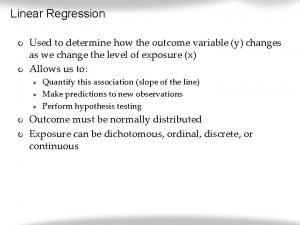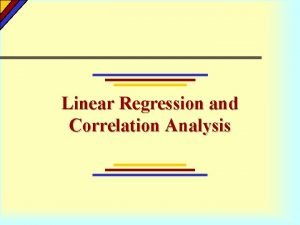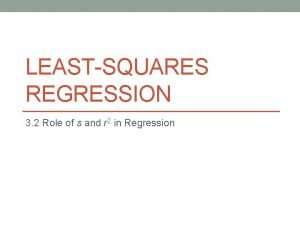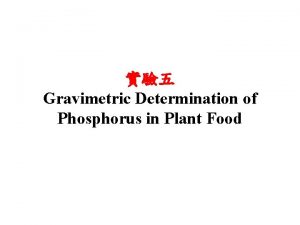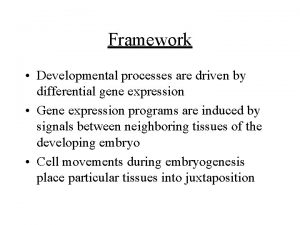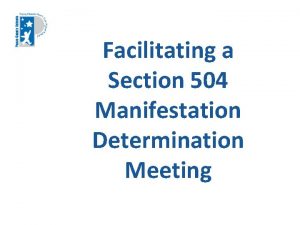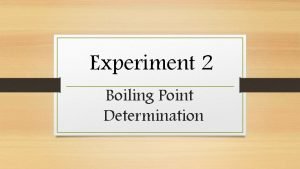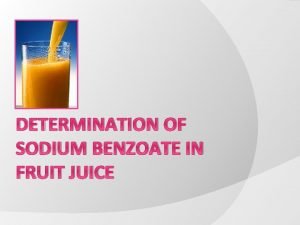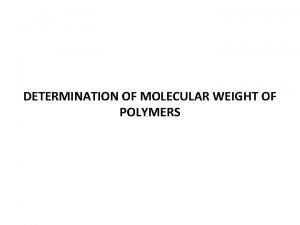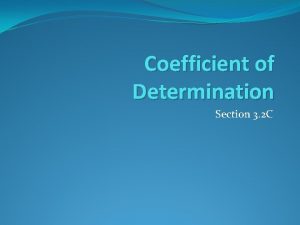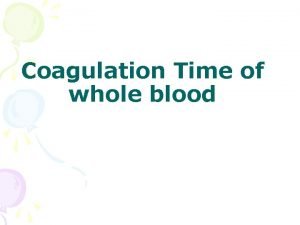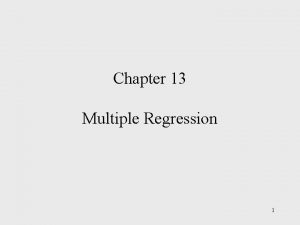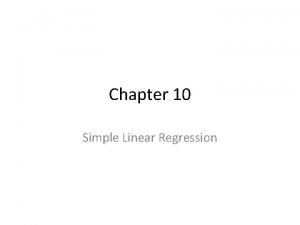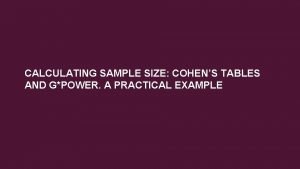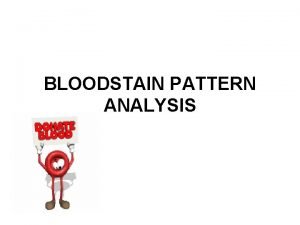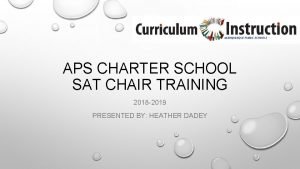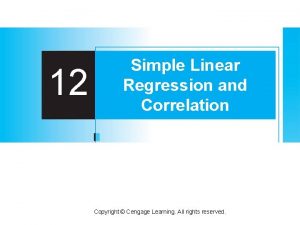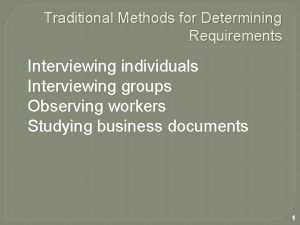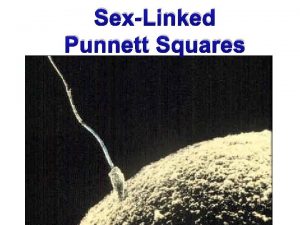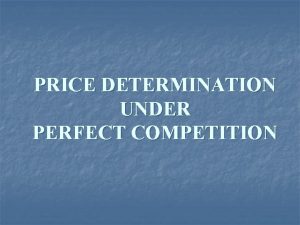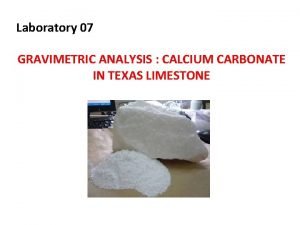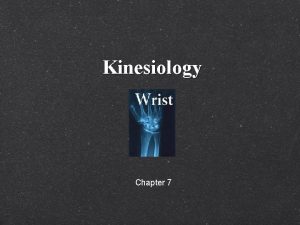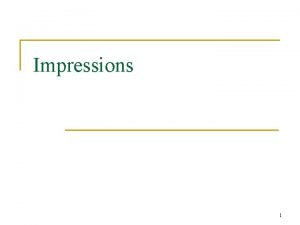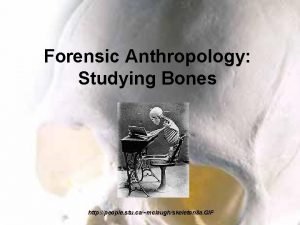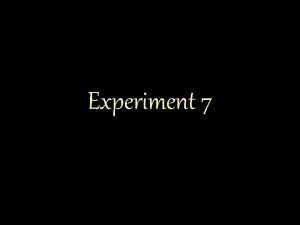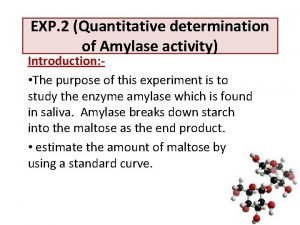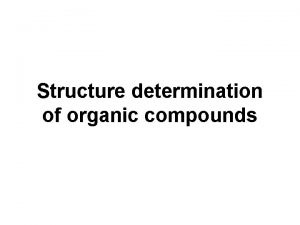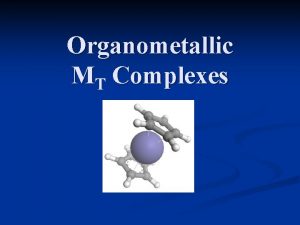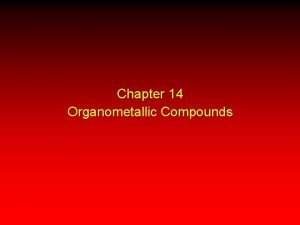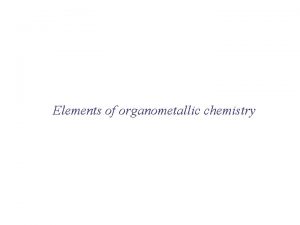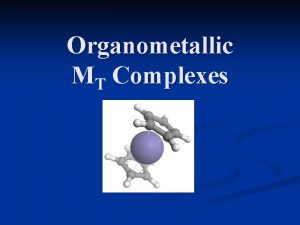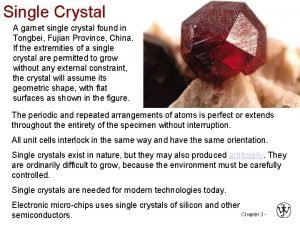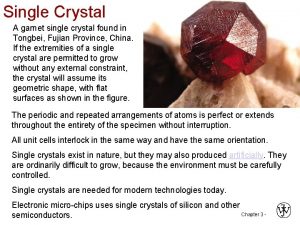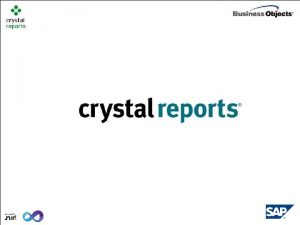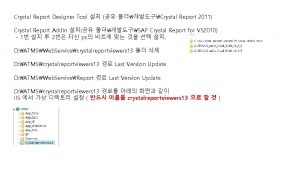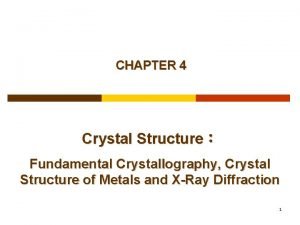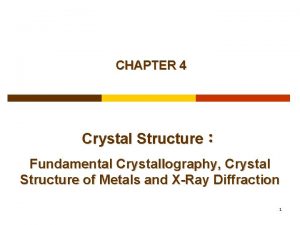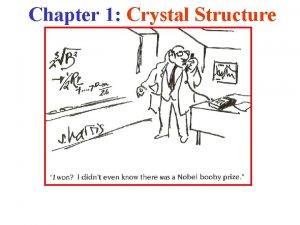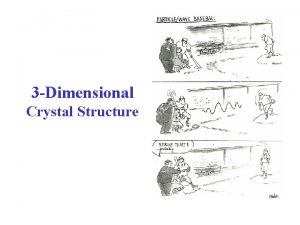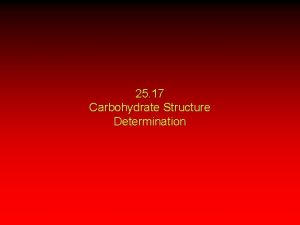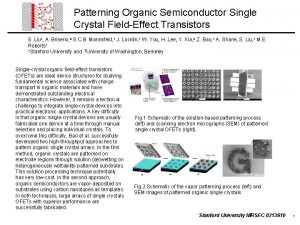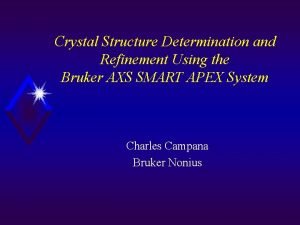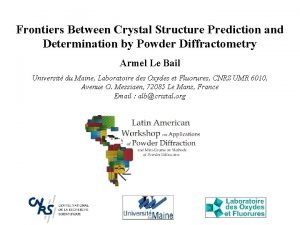Single Crystal Structure Determination of Organic and Organometallic


































































































- Slides: 98

Single Crystal Structure Determination of Organic and Organometallic Compounds A. L. (Ton) Spek National Single Crystal Service Facility Utrecht University Amsterdam, 23 -10 -2007

Single Crystal X-Ray Structure Determination Nowadays: THE technique in support of synthetic chemistry either to confirm a proposed structure or to solve a puzzle. BLACK BOX Single Crystals 3 D-Structure X-Ray Diffraction Experiment

Some History • The first X-ray structure determination was carried out around 1913 (Bragg). • In the sixties, 40 years ago, a small molecule crystal structure determination still took in the order of half a year. • Main problems were the time consuming data collection, the solution of the ‘Phase Problem’ and the scarce and slow university main frame computing facilities. • We received in the late 70 th an interesting request from a synthetic chemist interested in the 3 D structure of a new compound: ‘. . Can you inject this sample in your diffractometer. . ’, a request that looked naïve at the time. • In hindsight he was visionary, since …

Announced Aug 2007: Tabletop ‘Black Box’ – Smart X 2 S Crystal Structure ?

Current Status • Data collection and evaluation procedures have now evolved to a level that a subset of the routine samples can indeed be analyzed automatically in a matter of hours. • The problem is that many real world samples still turn out to be non-routine. • Thus still a working knowledge is needed of what is in the box … in order to get a reliable structure.

Black Box => Gray Box Two sub-boxes Crystal X-Ray Diffraction Experiment -Unitcell info -H K L, I, (I) Computation -Solution of the phase problem -3 D model x, y, z

X-Ray Diffraction Experiment X-Ray Sources • Sealed Tube (Cu. Ka, Mo. Ka) 1 -3 k. W • Rotating Anode (Cu. Ka, Mo. Ka) ~ 10 k. W • Rotating Anode + Focussing Mirrors • New: Microsource ~30 W Low Temperature Unit for the best data

X-Ray Diffraction Experiment Reflection Registration. Techniques • 2 D-X-Ray Film (Weissenberg Camera etc. ) • 1 D-Point Detector (Scientilation counter – CAD 4 Automation • 2 D-Image Plate • CCD 2 D Detector (Kappa. CCD, APEX) • Future? Real time 2 D low noise, shutterless detectors

X-Ray source, Goniometer & Serial Detector

LNT CCD - Detector X-ray Crystal Goniometer X-ray source, goniometer + crystal, N 2 -cooling and CCD Detector

One of the several hundreds of CCD images with diffraction spots

Data Collection • Diffraction Condition (determines the position of the diffracted beams on the detector): 2 dhkl sin(Q) = n l (Bragg Equation) • Result: - Cell Dimensions, a, b, c, a, b, g - Reflection intensities by planes (hkl) in the crystal: I(hkl) (many thousands)

Computation • • Data Reduction to hkl I and (I) Correction for absorption effects Determination of the Space Group Solution of the Phase Problem Abstraction of a Parameter Model from 3 D-density map Refinement of the Structural Model Analysis of the geometry, intermolecular interactions Structure Validation

Data Reduction • Integration and scaling of the diffraction intensities • E. g. with programs (Generally comes with the hardware) DENZO, EVAL-CCD, SAINT

Correction for Absorption • Numerical correction based on the description of the crystal in terms of its bounding faces. • Correction based on Phi-scans (Serial Det. ) • Fitted ‘Absorption Surface’ based on multiple measured reflections with different setting angles (SADABS, TWINABS, MULABS etc. )

Determination of the Space Group Based on: • Cell Dimensions • Laue Symmetry • Intensity Statistics (Centro/Non-Centro) • Systematic Extinctions • Space Group Frequency in the CSD Note: Not always a unique proposal

Structure Determination • Experiment Ihkl |Fhkl| = Sqrt(Ihkl) • Needed for 3 D structure (approximate) Phases: fhkl |Fhkl| + fhkl = Fhkl 3 D-Fourier Synthesis r(x, y, z) = [ Shkl Fhkl exp{-2 i(hx + ky + lz)}] / V x, y, z are fractional coordinates (range 0 1) Example next slide

Contoured 2 D-Section Through the 3 D Structure

Solution of the Phase Problem • Direct Methods e. g. SHELXS, SHELXD, SIR, CRUNCH • Patterson Methods DIRDIF • Fourier Difference Maps (Structure Completion) • New: Charge Flipping

Abstracted and Interpreted Structure

3 D Parameter Model • Extract the 3 D Coordinates (x, y, z) of the atoms. • Assign Atom Types (Scattering type C, O etc. ) • Assign Additional Parameters to Model the Thermal Motion (T) of the Atoms. • Other Parameters: Extinction, Twinning, Flack x • Model: Fhkl = Sj=1, n fj T exp{2 i(hx + ky + lz)} • Non-linear Least-squares Parameter Refinement until Convergence. • Minimize: Shkl w [(Fhklobs)2 – (Fhklcalc)2]2 • Agreement Factor: R = S |Fobs – Fcalc| / S|Fobs|

Refinement of the Structural Model Refinement Steps (Programs SHELXL, Crystals, XTAL etc) 1. Refine positional parameters + isotropic U 2. Refine positional + anisotropic parameters 3. Introduce H-atoms 4. Refine H-atoms with x, y, z, U(iso) or riding on their carrier atoms 5. Refine weighting scheme 6. ORTEP presentation


Analysis of the Geometry and Intermolecular Interactions Programs: PLATON, PARST etc • Bond distances, angles, torsion angles, ring (puckering) geometry etc. • Intermolecular Contacts Hydrogen Bonds (O-H. . O, N-H. . O, O-H. . )

Structure Validation • • • Refinement results in CIF File format. Final Fobs/Fcalc data in FCF File Format IUCr CHECKCIF tool PLATON Validation Tool Check in Cambridge Crystallographic Database for similar structures.

Technical Issues and Problems • • • Poor crystal quality (e. g. fine needle bundles) Determination of the correct Space Group Symmetry Pseudo-Symmetry Absolute Structure of light atom structures Twinning Positional and substitutional disorder of part (or even the whole) molecule • Disordered Solvent • Incommensurate structures • Diffuse scattering, streaks, diffuse layers

Tools offered by PLATON • The program PLATON offers multiple tools that can be used to analyse and solve problems encountered in a single crystal structure determination • Next slide Main Feature Menu PLATON


Selected Tools • ADDSYM – Detection and Handling of Missed (Pseudo)Symmetry • Twin. Rot. Mat – Detection of Twinning • SOLV – Report of Solvent Accessible Voids • SQUEEZE – Handling of Disordered Solvents in Least Squares Refinement (Easy to use Alternative for Clever Disorder Modelling) • Bijvoet. Pair – Post-refinement Absolute Structure Determination (Alternative for Flack x) • VALIDATION – PART of IUCr CHECKCIF

ADDSYM • About 1% of the 2006 & 2007 entries in the CSD need a change of space group. • Often, a structure solves only in a space group with lower symmetry than the correct space group. The structure should subsequently be checked for higher symmetry. • Next slides: Recent examples of missed symmetry

WRONG SPACEGROUP J. A. C. S. (2000), 122, 3413 – P 1, Z = 2

CORRECTLY REFINED STRUCTURE P-1, Z=2

Organic Letters (2006) 8, 3175 P 1, Z’ = 8 C C o Correct Symmetry ?

Correct Space Group

After Transformation to P 212121, Z’ = 2

Organometallics (2004) 23, 2310

Change of Space Group ALERT

(Pseudo)Merohedral Twinning • Options to handle twinning in L. S. refinement available in SHELXL, CRYSTALS etc. • Problem: Determination of the Twin Law that is in effect. • Partial solution: coset decomposition, try all possibilities (I. e. all symmetry operations of the lattice but not of the structure) • ROTAX (S. Parson et al. (2002) J. Appl. Cryst. , 35, 168. (Based on the analysis of poorly fitting reflections of the type F(obs) >> F(calc) ) • Twin. Rot. Mat Automatic Twinning Analysis as implemented in PLATON (Based on a similar analysis but implemented differently)

Twin. Rot. Mat Example • Originally published as disordered in P 3. • Solution and Refinement in the trigonal space group P-3 R= 20%. • Run PLATON/Twin. Rot. Mat on CIF/FCF • Result: Twin law with an the estimate of the twinning fraction and the estimated drop in R-value • Example of a Merohedral Twin


Ideas behind the Algorithm • Reflections effected by twinning show-up in the least-squares refinement with F(obs) >> F(calc) • Overlapping reflections necessarily have the same Theta value within a tolerance. • Generate a list of implied possible twin axes based on the above observations. • Test each proposed twin law for its effect on the R -value.

Possible Twin Axis H” = H + H’ H Reflection with F(obs) >> F(calc) Candidate twinning axis (Normalize !) H’ Strong reflection H’ with theta close to theta of reflection H


Solvent Accessible Voids • A typical crystal structure has only in the order of 65% of the available space filled. • The remainder volume is in voids (cusps) in-between atoms (too small to accommodate an H-atom) • Solvent accessible voids can be defined as regions in the structure that can accommodate at least a sphere with radius 1. 2 Angstrom without intersecting with any of the van der Waals spheres assigned to each atom in the structure. • Next Slide: Void Algorithm: Cartoon Style

DEFINE SOLVENT ACCESSIBLE VOID STEP #1 – EXCLUDE VOLUME INSIDE THE VAN DER WAALS SPHERE

DEFINE SOLVENT ACCESSIBLE VOID STEP # 2 – EXCLUDE AN ACCESS RADIAL VOLUME TO FIND THE LOCATION OF ATOMS WITH THEIR CENTRE AT LEAST 1. 2 ANGSTROM AWAY

DEFINE SOLVENT ACCESSIBLE VOID STEP # 3 – EXTEND INNER VOLUME WITH POINTS WITHIN 1. 2 ANGSTROM FROM ITS OUTER BOUNDS

Listing of all voids in the triclinic unit cell Cg


VOID APPLICATIONS • Calculation of Kitaigorodskii Packing Index • As part of the SQUEEZE routine to handle the contribution of disordered solvents in crystal structure refinement • Determination of the available space in solid state reactions (Ohashi) • Determination of pore volumes, pore shapes and migration paths in microporous crystals

SQUEEZE • Takes the contribution of disordered solvents to the calculated structure factors into account by back-Fourier transformation of density found in the ‘solvent accessible volume’ outside the ordered part of the structure (iterated). • Filter: Input shelxl. res & shelxl. hkl Output: ‘solvent free’ shelxl. hkl • Refine with SHELXL or Crystals • Note: SHELXL lacks option for fixed contribution to Structure Factor Calculation.

SQUEEZE Algorithm 1. 2. 3. 4. 5. Calculate difference map (FFT) Use the VOID-map as a mask on the FFT-map to set all density outside the VOID’s to zero. FFT-1 this masked Difference map -> contribution of the disordered solvent to the structure factors Calculate an improved difference map with F(obs) phases based on F(calc) including the recovered solvent contribution and F(calc) without the solvent contribution. Recycle to 2 until convergence.

SQUEEZE In the Complex Plane Fc(total) Fobs Fc(solvent) Fc(model) Solvent Free Fobs Black: Split Fc into a discrete and solvent contribution Red: For SHELX refinement, temporarily substract recovered solvent contribution from Fobs.

Comment • The Void-map can also be used to count the number of electrons in the masked volume. • A complete dataset is required for this feature. • Ideally, the solvent contribution is taken into account as a fixed contribution in the Structure Factor calculation (CRYSTALS) otherwise it is subtracted temporarily from Fobs 2 (SHELXL) and re-instated afterwards with info saved beyond column 80 for the final Fo/Fc list.

Publication Note • Always give the details of the use of SQUEEZE in the comment section • Append the small CIF file produced by PLATON to the main CIF • Use essentially complete data sets with sufficient resolution only. • Make sure that there is no unresolved charge balance problem.

Absolute Structure Determination Complex Scattering Factors • Scattering factor: f = f 0 + f ’ + if ’’ Where: f 0 = a function of diffraction angle Q and equal to the number of electrons in the atom at Q = 0. f ‘and f ’’ atom type and l dependent i = sqrt(-1) • Note: A phase shift is often represented mathematically as a complex number.

Breakdown of Friedels Law • It can be derived from the expression for the calculated structure factor that for noncentrosymmetric crystal structures: |Fhkl| not necessarily equal to |F-h-k-l| for f “ > 0, thus breaking the earlier assumed Friedel Law: |Fhkl| = |F-h-k-l| (The Friedel Law still holds for centro-symmetric structures containing racemic mixtures of chiral compounds).

Friedel Pairs H, K, L -H, -K, -L Friedel Pair of Reflections

Selected f” - values f”(Cu. Kα) f”(Mo. Kα) Se 1. 14 2. 23 Cl 0. 70 0. 16 S 0. 56 0. 12 O 0. 032 0. 006

Flack Parameter • The current official method to establish the absolute configuration of a chiral molecule calls for the determination of the Flack x parameter. Flack, H. D. (1983). Acta Cryst. A 39, 876 -881. • Twinning Model (mixture model and image): Ihklcalc = (1 – x) |Fhkl|2 + x |F-h-k-l|2 • Result of the least-squares refinement: x(u) Where x has physically a value between 0 and 1 and u the standard uncertainty (‘esd’)

Interpretation of the Flack x • H. D. Flack & G. Bernardinelli (2000) J. Appl. Cryst. 33, 1143 -1148. • For a statistically valid determination of the absolute structure: u should be < 0. 04 and |x| < 2 u • For a compound with known enantiopurity: u should be < 0. 1 and |x| < 2 u

Post-Refinement Absolute Structure Determination • Unfortunately, many pharmaceuticals contain in their native form only light atoms that at best have only weak anomalous scattering power and thus fail the strict Flack conditions. • Alternative approaches are offered by PLATON with scatter plots and the determination of the Hooft y parameter

Scatter Plot of Bijvoet Differences • Plot of the Observed Bijvoet (Friedel) Differences against the Calculated Differences. • A Least-Squares line is calculated • The Green least squares line should run from the lower left to the upper right corner for the correct absolute structure. • Vertical bars on data points indicate the su on the Bijvoet Difference. Example

Excellent Correlation

Mo. Ka, P 212121 Example: Ammonium Bitartrate Test

Ammonium Bi. Tartrate (Mo. Ka)

Bayesian Approach • Rob Hooft (Bruker) has developed an alternative approach for the analyses of Bijvoet differences that is based on Bayesian statistics. (Paper under review) • Under the assumption that the material is enantiopure, the probability that the assumed absolute structure is correct, given the set of observed Bijvoet Pair Differences, is calculated. • An extension of the method also offers the Fleq y (Hooft y) parameter to be compared with the Flack x. • Example: Ascorbic Acid, P 21, Mo. Ka data

Mo. Ka Natural Vitamin C, L-(+)Ascorbic Acid

L-(+) Ascorbic Acid

Hooft y Proper Procedure • Collect data with an essentially complete set of Bijvoet Pairs • Refine in the usual way (preferably) with BASF and TWIN instructions (SHELXL) • Structure Factors to be used in the analysis are recalculated in PLATON from the parameters in the CIF (No Flack x contribution).

Do we need Validation ? Some Statistics • • • Validation CSD Entries 2006 + 2007 Number of entries: 35760 # of likely Space Group Changes: 384 # of structures with voids: 3354 Numerous problems with H, O, OH, H 2 O etc. • Example

Organometallics (2006) 25, 1511 -1516 Next Slide: This is why the reported density is low and the R and Rw high

Solvent Accessible Void of 235 Ang 3 out of 1123 Ang 3 Not Accounted for in the Refinement Model

SOLUTION A solution for the structure validation problem was pioneered by the International Union of Crystallography - Provide and archive crystallographic data in the computer readable CIF standard format. - Offer Automated validation, with a computer generated report for authors and referees. - Have journals enforce a structure validation protocol. - The IUCr journals and most major journals now indeed implement some form of validation procedure.

THE CIF DATA STANDARD - Driving Force: Syd Hall (IUCr/ Acta Cryst C) Early Adopted by XTAL & SHELX(T)L. Currently: Win. GX, Crystals, Texsan, Maxus etc. Acta Cryst. C/E – Electronic Submission Acta Cryst. : Automatic Validation at the Gate CIF data available for referees for detailed inspection (and optional calculations). - Data retrieval from the WEB for published papers - CCDC – Deposition in CIF-FORMAT.

VALIDATION QUESTIONS Single crystal validation addresses three simple but important questions: 1 – Is the reported information complete? 2 – What is the quality of the analysis? 3 – Is the Structure Correct?

IUCr CHECKCIF WEB-Service http: //checkcif. iucr. org reports the outcome of: • IUCr standard tests Consistency, Missing Data, Proper Procedure, Quality etc. • + Additional PLATON based tests Missed Symmetry, Twinning, Voids, Geometry, Displacement Parameters, Absolute Structure etc.

ALERT LEVELS • • ALERT A – Serious Problem ALERT B – Potentially Serious Problem ALERT C – Check & Explain ALERT G – Verify or Take Notice

ALERT TYPES 1 - CIF Construction/Syntax errors, Missing or Inconsistent Data. 2 - Indicators that the Structure Model may be Wrong or Deficient. 3 - Indicators that the quality of the results may be low. 4 - Cosmetic Improvements, Queries and Suggestions.

EXAMPLE OF PLATON GENERATED ALERTS FOR A RECENT PAPER PUBLISHED IN J. Amer. Chem. Soc. (2007) Attracted special attention in Chemical and Engineering News Properly Validated ?

Problems Addressed by PLATON/CIF-CHECK - Missed Higher Space Group Symmetry Solvent Accessible Voids in the Structure Unusual Displacement Parameters Hirshfeld Rigid Bond test Misassigned Atom Type Population/Occupancy Parameters Mono Coordinated/Bonded Metals Isolated Atoms (e. g. O, H, Transition Metals)

More Problems Addressed by PLATON - Too Many Hydrogen Atoms on an Atom Missing Hydrogen Atoms Valence & Hybridization Short Intra/Inter-Molecular Contacts O-H without Acceptor Unusual Bond Length/Angle CH 3 Moiety Geometry To be extended with tests for new problems ‘invented’ by authors.

Additional Problems Addressed by PLATON/FCF-CHECK • • Information from. cif and. fcf files Report on the resolution of the data Report about randomly missing data Check the completeness of the data (e. g. for missing cusps of data • Report on Missed (Pseudo) Merohedral Twinning • Report on Friedel Pairs and Absolute Structure • Next Slide: ASYM VIEW Display for the inspection of the data completeness

Section in reciprocal space Missing cusp of data

Incorrectly Oriented O-H • The O-H moiety is generally, with very few exceptions, part of a D-H. . A system. • An investigation of structures in the CSD brings up many ‘exceptions’. • Closer analysis shows that misplacement of the OH hydrogen atom is in general the cause. • Molecules have an environment in the crystal ! • Example

Example of a PLATON/Check Validation Report: Two ALERTS related to the misplaced Hydrogen Atom

Difference Electron Density Map

Validation Looks at inter-molecular contacts Unsatisfactory Hydrogen Bond Network Correct ! ALERT !

QUATERNION FIT • In many cases, an automatic molecule fit can be performed • A) Identical atom numbering • B) Sufficient number of Unique Atoms • C) By manual picking of a few atom pairs


QUATERNION FIT


Simulated Powder Patterns • It is not always apparent that two crystal structures are identical. The assigned unit cell or space group can differ. • Comparison of the associated calculated powder patterns should solve the issue. • Example for the CSD:

Tetragonal “Orthorhombic”

THE MESSAGE - Validation should not be postponed to the publication phase. All validation issues should be taken care of during the analysis. - Everything unusual in a structure is suspect, mostly incorrect (artifact) and should be investigated and discussed in great detail and supported by additional independent evidence. - The CSD can be very helpful when looking for possible precedents.

CONCLUSION Validation Procedures are excellent Tools to: - Set Quality Standards (Not just on R-Value) - Save a lot of Time in Checking, both by the Investigators and the Journals (referees) - Point at Interesting Features (Pseudo-Symmetry, short Interactions etc. ) to be discussed. - Surface a problem that only an experienced Crystallographer might be able to Address - Proof of a GOOD structure.

Additional Info http: //www. cryst. chem. uu. nl (including a copy of this powerpoint presentation) Thanks for your attention !!

 Types of organometallic compounds
Types of organometallic compounds Sidwick rule
Sidwick rule Organometallic
Organometallic Organometallic
Organometallic 오비탈
오비탈 Single crystal diffractometer
Single crystal diffractometer Ion dipole forces
Ion dipole forces Fcc slip directions
Fcc slip directions Protein structure determination
Protein structure determination Octane lewis structure
Octane lewis structure Cscl structure
Cscl structure Silicon unit cell
Silicon unit cell Titanium crystal structure
Titanium crystal structure Giant ionic lattice sodium chloride
Giant ionic lattice sodium chloride Miller indices examples
Miller indices examples Piezoelectric crystal atomic structure
Piezoelectric crystal atomic structure Lattice +basis is
Lattice +basis is Crystal structure of ceramics
Crystal structure of ceramics What is ideal crystal
What is ideal crystal Crystalline solid
Crystalline solid Metallic crystal structure
Metallic crystal structure What is motif in crystal structure
What is motif in crystal structure Organic structure characteristics
Organic structure characteristics Organic structure characteristics
Organic structure characteristics Sisd simd misd mimd examples
Sisd simd misd mimd examples Single instruction single data
Single instruction single data Single channel single phase example
Single channel single phase example X linked dominant inheritance punnett square
X linked dominant inheritance punnett square Sex determination in drosophilla
Sex determination in drosophilla Quality determination
Quality determination Price and output determination under oligopoly
Price and output determination under oligopoly Sex determination and sex linkage
Sex determination and sex linkage Software process improvement and capability determination
Software process improvement and capability determination Price and output determination under monopoly
Price and output determination under monopoly Exchange rate determination and forecasting
Exchange rate determination and forecasting Price discovery and price determination
Price discovery and price determination Three bus structure in computer organization
Three bus structure in computer organization 7 crystal systems and 14 bravais lattices
7 crystal systems and 14 bravais lattices Mechanical entrapment coprecipitation
Mechanical entrapment coprecipitation 7 crystal systems and 14 bravais lattices
7 crystal systems and 14 bravais lattices Occlusion in gravimetric analysis
Occlusion in gravimetric analysis Crystal binding and elastic constants
Crystal binding and elastic constants Crystal solid and amorphous solid
Crystal solid and amorphous solid Crystal binding and elastic constants
Crystal binding and elastic constants Peptization
Peptization Bragg's law in reciprocal lattice
Bragg's law in reciprocal lattice Coefficient of determination interpretation
Coefficient of determination interpretation Blank determination example
Blank determination example Brain pop sex ed
Brain pop sex ed Self advocate
Self advocate What is a sample size
What is a sample size Shipping point determination
Shipping point determination Shipping point determination sap
Shipping point determination sap R squared interpretation
R squared interpretation Jad session interview questions
Jad session interview questions Coefficient of determination in r
Coefficient of determination in r Bradford method
Bradford method Determination in sanskrit
Determination in sanskrit Serious tone
Serious tone Grit personality trait
Grit personality trait Microhematocrit reading
Microhematocrit reading Coefficient of determination interpretation
Coefficient of determination interpretation Linear regression example
Linear regression example How to find lsrl
How to find lsrl Gravimetric determination of phosphorus in plant food
Gravimetric determination of phosphorus in plant food Differentiation vs determination
Differentiation vs determination Manifestation determination meeting agenda
Manifestation determination meeting agenda Boiling point determination experiment
Boiling point determination experiment Chemical energy
Chemical energy Determination of sodium benzoate in fruit juice
Determination of sodium benzoate in fruit juice Biopolymer molecular weight determination
Biopolymer molecular weight determination Calculate the coefficient of determination
Calculate the coefficient of determination Slide method of clotting time
Slide method of clotting time Is determination a character trait
Is determination a character trait Personal services business determination
Personal services business determination Adjusted multiple coefficient of determination
Adjusted multiple coefficient of determination Correlation and regression
Correlation and regression Calculation of coefficient of determination
Calculation of coefficient of determination Cohen d effect size
Cohen d effect size Cast-off blood spatter
Cast-off blood spatter Canvas.aps
Canvas.aps Manifestation determination flowchart
Manifestation determination flowchart Air self determination scale
Air self determination scale Uniform determination of death act 1981
Uniform determination of death act 1981 Coefficient of determination formula in regression
Coefficient of determination formula in regression Traditional methods for determining requirements
Traditional methods for determining requirements Air self determination scale
Air self determination scale Hemophilia punnet square
Hemophilia punnet square Nc residency determination service
Nc residency determination service Price determination under perfect competition
Price determination under perfect competition Loyalty quotes in the odyssey
Loyalty quotes in the odyssey Ash content determination
Ash content determination Gravimetric determination of calcium lab report
Gravimetric determination of calcium lab report Eaton hand
Eaton hand What is used to make a cast of a tool mark?
What is used to make a cast of a tool mark? Nasal silling/guttering skull
Nasal silling/guttering skull Gravimetric principle
Gravimetric principle Maltose standard curve
Maltose standard curve What is transport number in electrochemistry
What is transport number in electrochemistry
